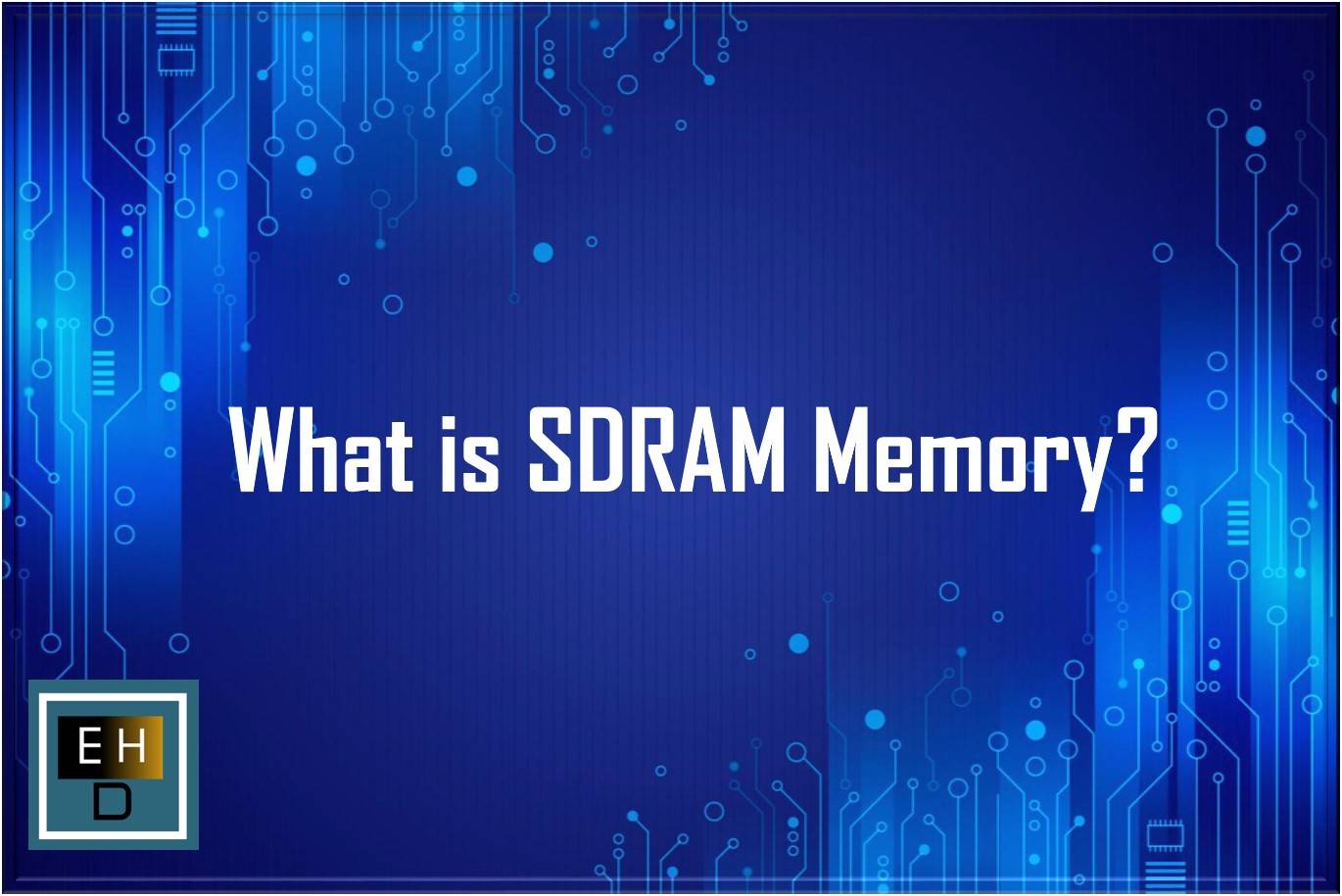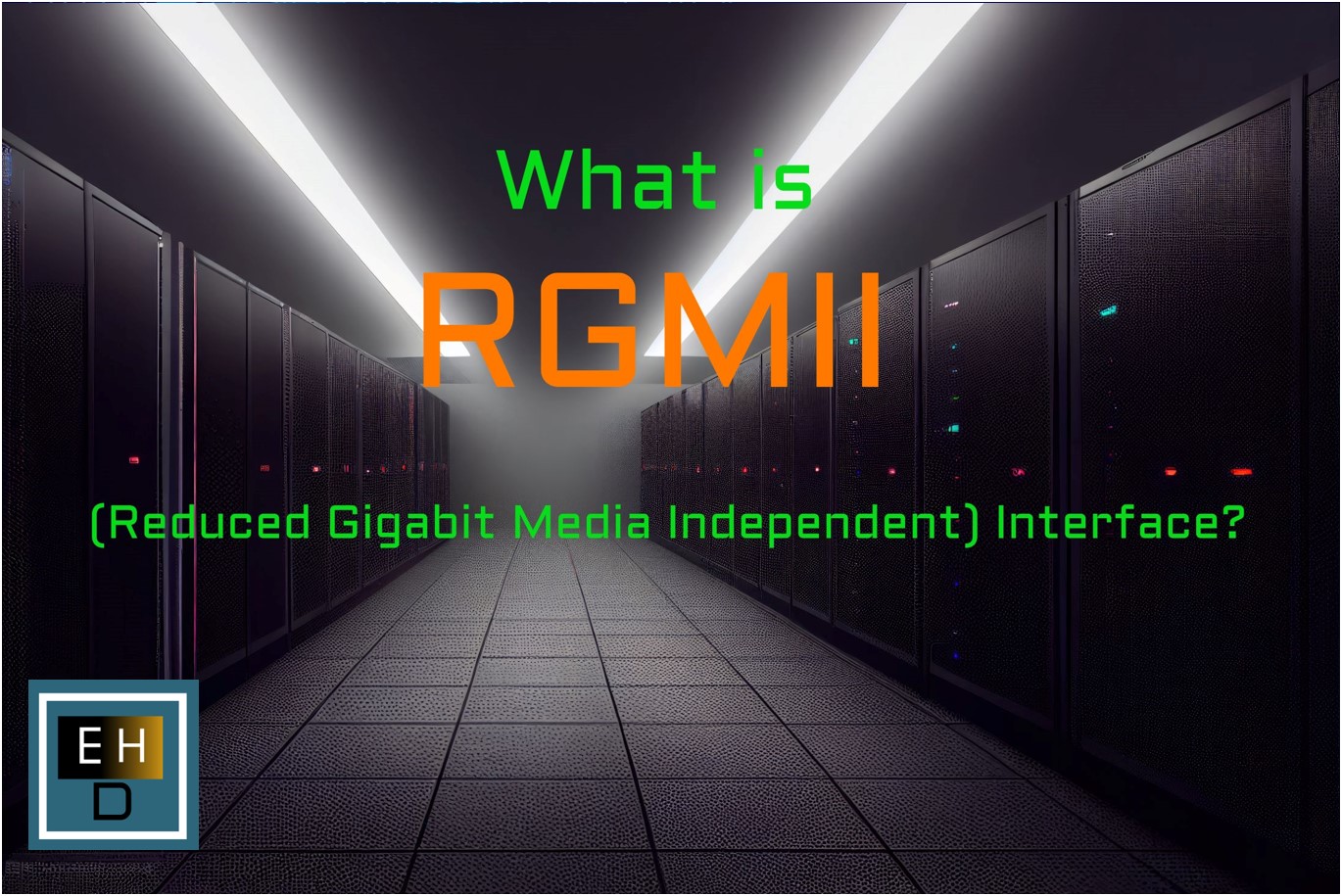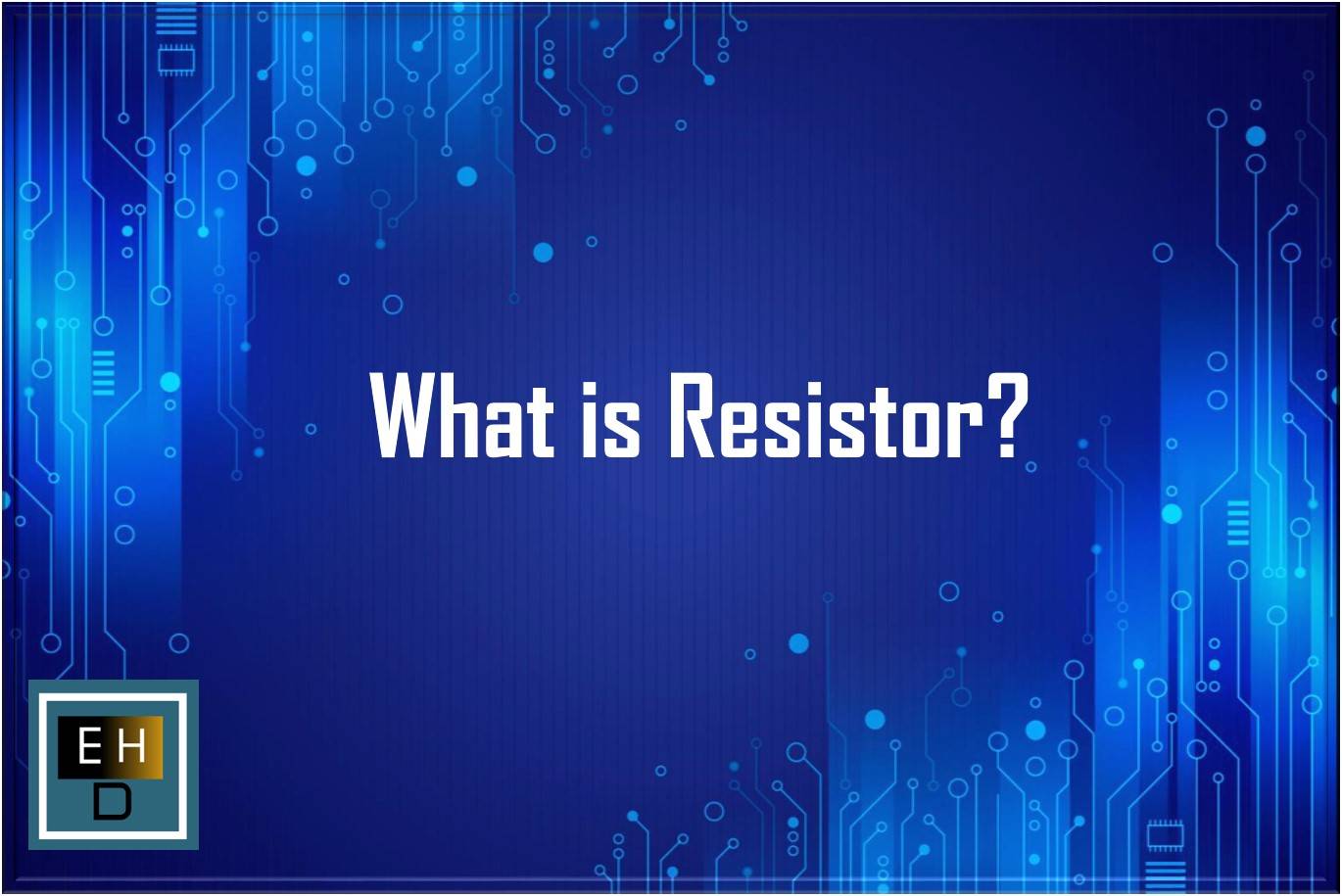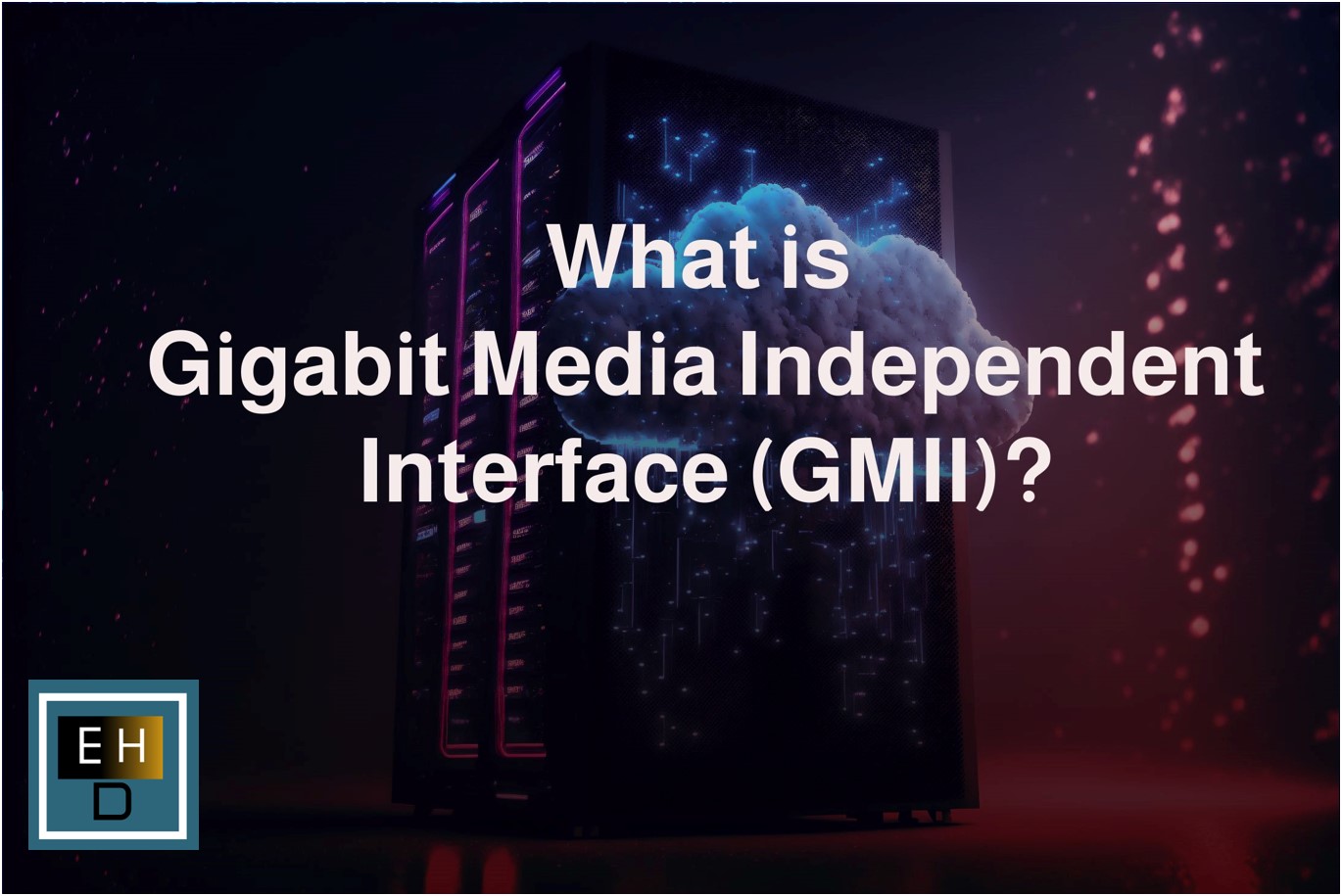USB (Universal Serial Bus) is an industry-standard introduced in 1996 to standardize the connection of peripherals to computers, replacing interfaces like serial, parallel, game, and ADB ports. It allows for data exchange and power delivery between hosts (e.g., personal computers), peripheral devices (e.g., displays, keyboards, and mass storage devices), and intermediate hubs that expand a host’s ports.
Early USB versions became common in devices like keyboard, mouse, camera, and smartphone. USB 1.0, introduced in 1996, supported data transfer rates of 1.5 Mbit/s (Low Speed) and 12 Mbit/s (Full Speed).
USB 2.0, released in 2000, offered up to 480Mbps but had limitations like half-duplex communication and power usage capped at 500mA.
Also Read : Media-Independent Interface (MII & RMII) in Ethernet
USB 3.0, launched in 2008, overcame these with 5Gbps transfer rates, full-duplex communication, and 900mA power usage. USB has become the dominant interface for rapid data transfer between devices.
In applications requiring USB as an interface, a USB switch can be useful for routing USB signals, shortening design cycles, and enabling debugging without disrupting device operations. USB switches are particularly useful in docking applications, WiFi storage, KVM switches, and GPS systems.
Historical Context: Evolution of USB standards (USB 1.0, 2.0, 3.x, 4.0).
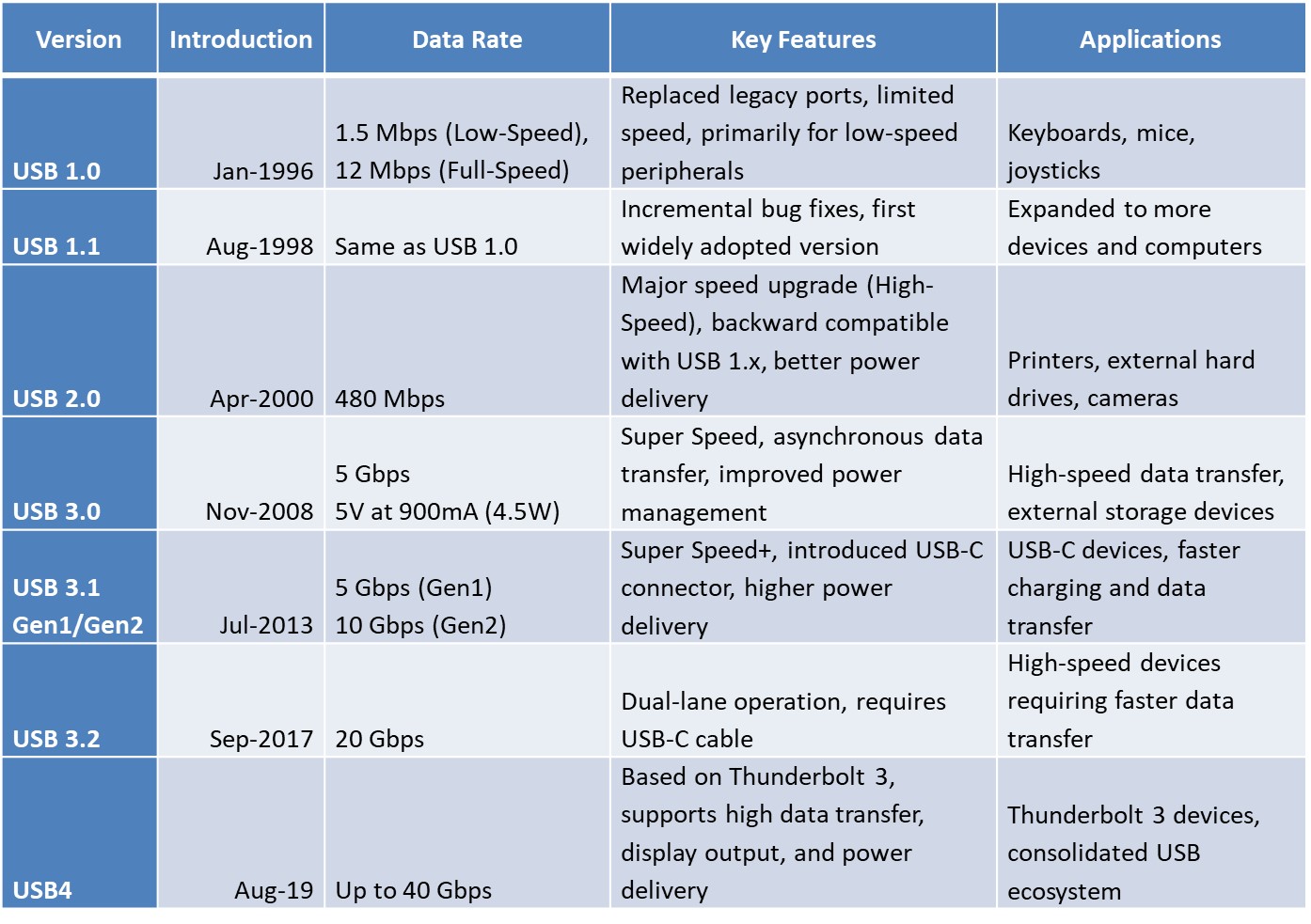
Key Purposes of USB
- Universal Connectivity:
- Standardization: USB provides a standardized interface that works across different devices and platforms, eliminating the need for multiple types of connectors and ports.
- Plug-and-Play: Devices can be connected or disconnected without needing to restart the host system, thanks to USB’s plug-and-play capabilities.
- Data Transfer:
- Efficient Communication: USB allows for the efficient transfer of data between a host device (like a computer) and peripheral devices. This data can include anything from text files to multimedia content.
- Varied Speed Options: Different versions of USB (e.g., USB 2.0, USB 3.0) offer different data transfer speeds, catering to various needs, from simple document transfers to high-speed file transfers.
- Power Supply:
- Power Delivery: USB can provide power to connected devices, making it possible to charge devices such as smartphones, tablets, and other peripherals directly through the USB connection.
- Versatility: With advancements like USB Power Delivery (USB PD), the interface can now supply varying levels of power, supporting a wide range of devices from small accessories to laptops.
- Ease of Use:
- User-Friendly: USB is designed to be easy to use, with reversible connectors in newer versions (USB-C), reducing the frustration associated with connecting devices.
- Broad Compatibility: USB interfaces are compatible with almost all modern operating systems, ensuring widespread usability across different platforms.
- Cost-Effective:
- Reduced Complexity: By standardizing connections, USB reduces the complexity and cost of designing, manufacturing, and purchasing peripherals and host systems.
USB 1.0
USB 1.0, introduced in January 1996, was the first version of the Universal Serial Bus standard designed to simplify peripheral device connectivity to computers. It offered two data transfer modes: Low-Speed at 1.5 Mbps for basic devices like keyboards and mice, and Full-Speed at 12 Mbps for peripherals such as early printers and scanners.
Key features included plug-and-play functionality, allowing devices to be connected or disconnected without restarting the computer, and a standardized connector to reduce the need for multiple port types. However, USB 1.0 saw limited adoption due to its relatively low transfer speeds and early development challenges.
USB 1.1
USB 1.1, released in September 1998, was an incremental upgrade over USB 1.0, addressing several bugs and inconsistencies in the original specification. It retained the same data transfer rates, offering Low-Speed at 1.5 Mbps and Full-Speed at 12 Mbps.
Despite minimal changes to speed, USB 1.1 became the first widely adopted USB standard, expanding its use across a broader range of devices, including mass storage devices like early USB flash drives.
USB 2.0
USB 2.0, released in April 2000, represented a major advancement in performance and functionality over USB 1.1. It introduced a High-Speed mode with a data transfer rate of 480 Mbps, a significant improvement over the 12 Mbps offered by USB 1.1.
Key features included backward compatibility with USB 1.1, allowing older devices to connect to USB 2.0 ports, and an enhanced power supply of 2.5W (5V at 500mA), enabling support for a wider range of bus-powered devices.
USB 2.0’s high data transfer rates and improved power capabilities made it the standard for connecting peripherals such as external hard drives, printers, and scanners, driving widespread adoption across consumer electronics and becoming the dominant standard for many years.
USB 3.0
USB 3.0, also known as SuperSpeed USB, was introduced in November 2008 and brought significant enhancements in data transfer speeds and efficiency. It offered a SuperSpeed mode with a transfer rate of 5 Gbps, a tenfold increase over USB 2.0’s High-Speed mode.
Key features included improved power management, reducing energy consumption when devices are idle, and increased power output of up to 4.5W (5V at 900mA), supporting more power-hungry devices. USB 3.0 ports are often distinguished by their blue color and maintain backward compatibility with USB 2.0, allowing older devices to connect seamlessly.
USB 3.1
Released in July 2013, USB 3.1 enhanced USB 3.0 by offering even faster data transfer rates with its SuperSpeed+ mode, reaching 10 Gbps—doubles the speed of USB 3.0.
Key features of USB 3.1 included the introduction of the USB-C connector, which is reversible and versatile, supporting higher power delivery, faster data transfer, and alternative modes like Display Port. Additionally, USB 3.1 improved power delivery capabilities, with support for USB Power Delivery (USB PD).
USB 3.x devices typically provide power at 5V and 900mA (4.5W), which supports standard peripherals and some charging applications. USB Battery Charging 1.2 enhances this by enabling power delivery for more demanding devices like external hard drives.
USB Power Delivery (USB PD) offers greater flexibility, allowing for variable voltage and current up to 20V and 5A (100W). It supports multiple power profiles, including 5V, 9V, 15V, and 20V, accommodating a broad range of devices from smart phones to laptops and even some low-power monitors and small appliances. USB PD is most commonly used with USB-C connectors, which enable high power delivery and fast charging capabilities.
USB 3.2
Released in September 2017, USB 3.2 advanced the USB 3.1 standard by increasing data transfer rates through dual-lane operation, achieving speeds of up to 20 Gbps using two 10 Gbps lanes. It fully adopted the USB-C connector, establishing it as the standard for modern USB technology.
USB 3.2’s enhanced performance significantly benefits data-intensive applications, such as video editing and high-resolution file transfers, by providing faster and more efficient data transfer capabilities.
USB 4.0
Announced in August 2019, USB4 is the latest USB standard, offering enhanced performance and compatibility. It supports data transfer rates of up to 40 Gbps, matching Thunderbolt 3. Key features include full compatibility with Thunderbolt 3 devices, which unifies high-speed data transfer, video output, and power delivery through a single USB-C port.
USB4 also aims to streamline the USB ecosystem by consolidating multiple standards into one, reducing consumer confusion. It supports advanced USB Power Delivery with up to 100W of power, making it suitable for a range of devices from smartphones to laptops, and can handle multiple data and display protocols simultaneously for versatile device connections and docking solutions.
USB Power Delivery
USB power standards have evolved to support a wide range of devices with varying power requirements. USB 2.0 provides a maximum power output of 5V at 0.5A (2.5W), suitable for low-power devices like keyboards and mice.
USB 3.0/3.1 increases this to 5V at 0.9A (4.5W), supporting higher-power peripherals like external hard drives.
The USB Battery Charging (BC) 1.2 standard delivers 5V at 1.5A (7.5W), designed for faster charging of smartphones and tablets. USB Power Delivery (USB PD) allows dynamic power negotiation, offering up to 100W (20V, 5A) for devices like laptops and monitors, and is often used with USB-C connectors.
USB-C itself supports up to 100W with USB PD, providing higher power and faster data transfer, and is becoming the universal charging standard for phones, laptops, and more. Here’s a table summarizing the USB power standards:
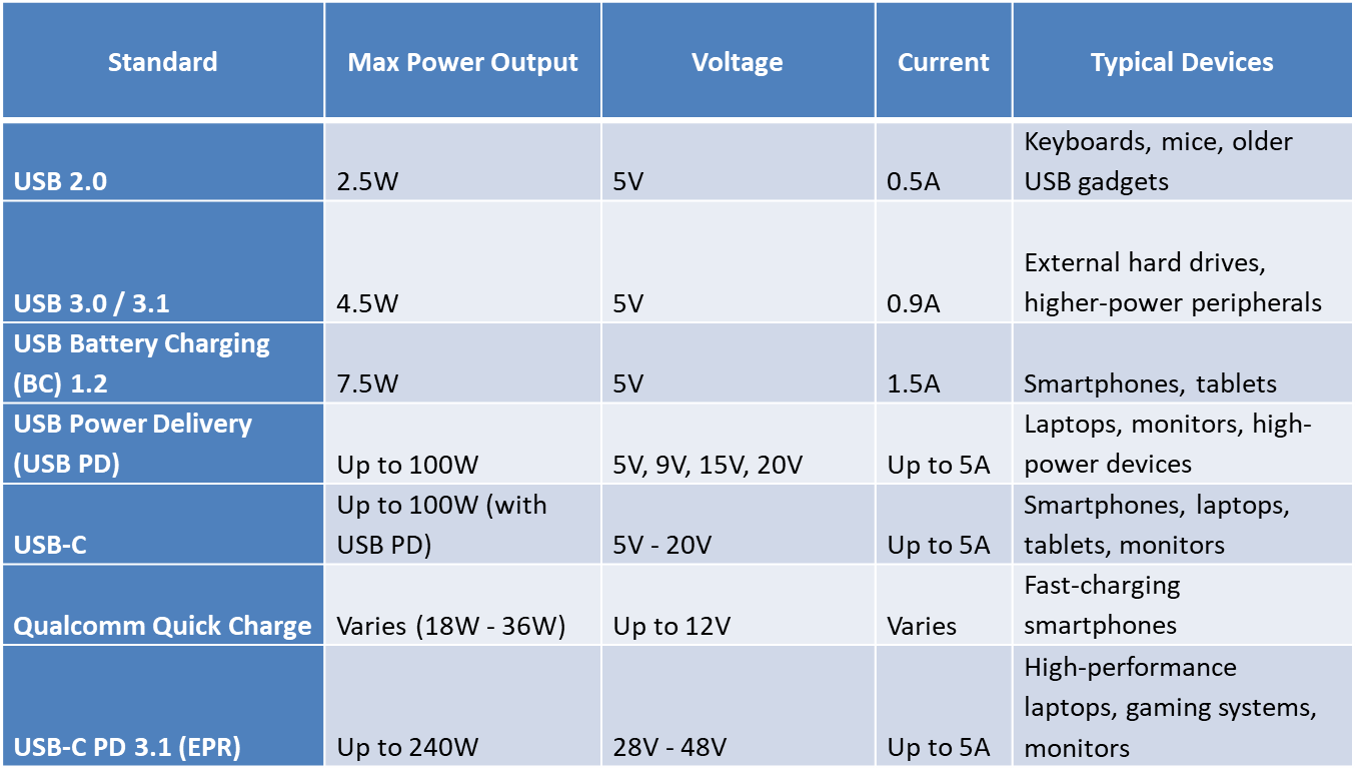 USB Physical Interface
USB Physical Interface
The physical interface of USB involves various connectors, ports, and cables designed to handle different devices, data rates, and power requirements. Below is an overview of the key components of the USB physical interface:
Types of USB Connectors and Ports
USB Type A Connectors
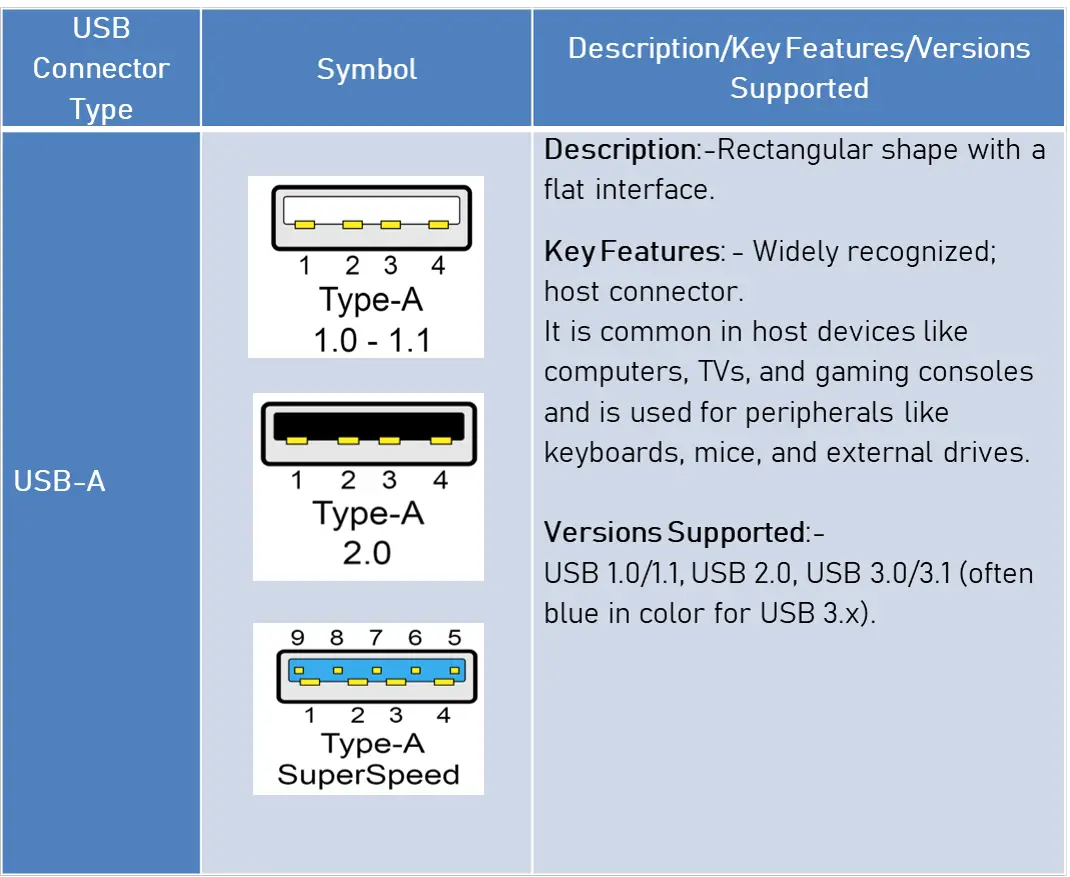
USB Type B Connectors
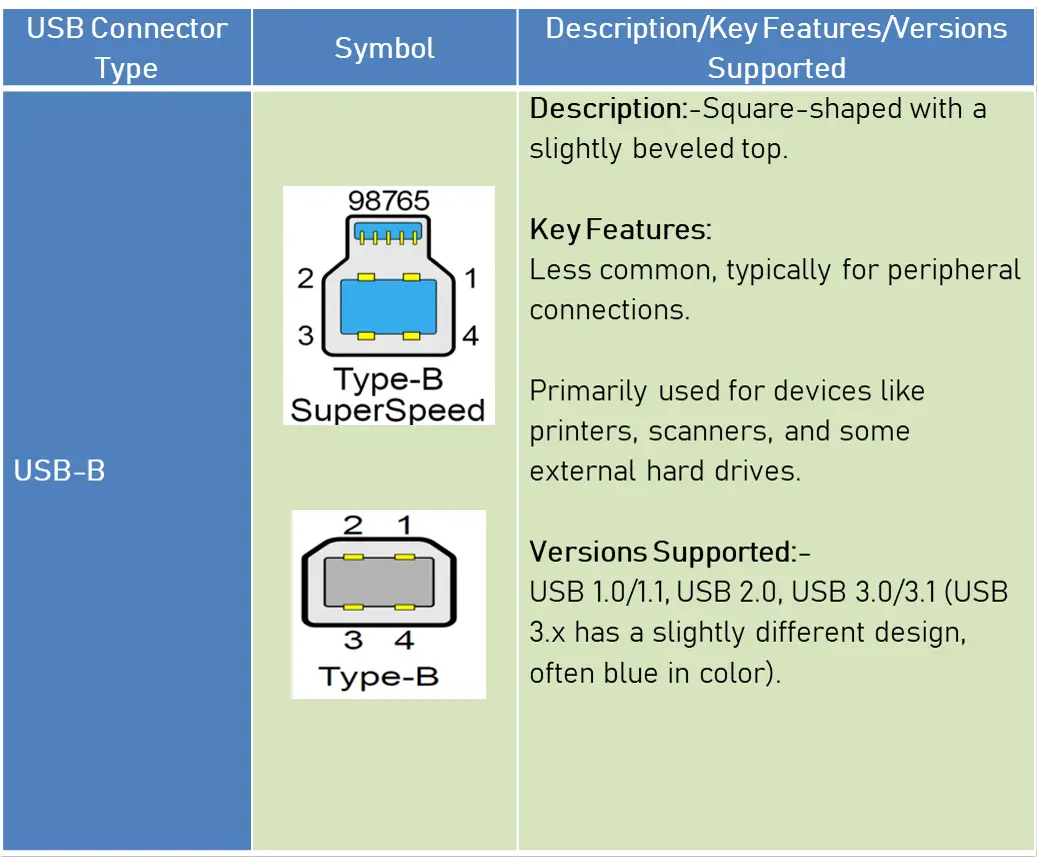
Mini-USB Type Connectors

Micro-USB Type Connectors
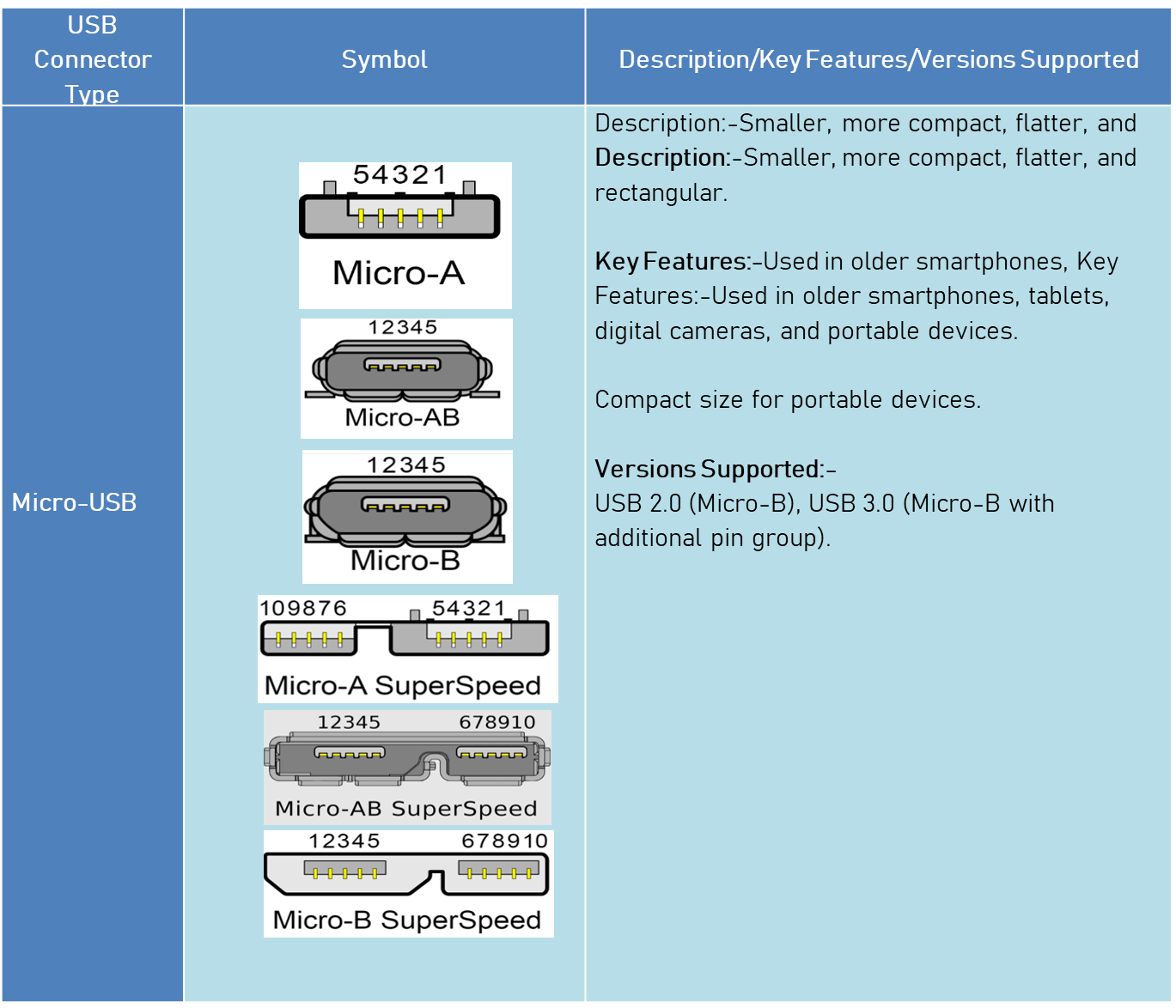
USB Type C Connectors
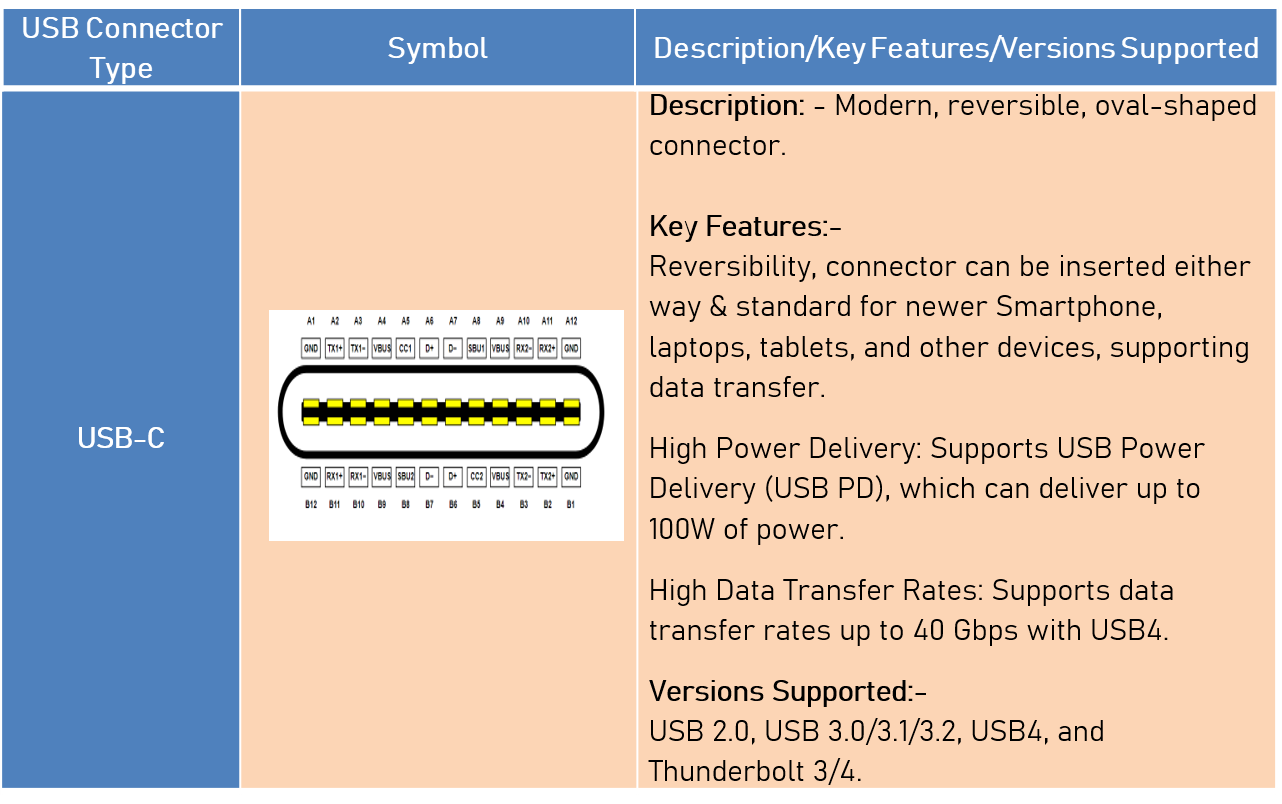 USB Device Classes
USB Device Classes
USB device classes categorize devices based on their functionality, allowing the operating system to load the appropriate drivers and manage communication with the device. Below are the primary USB device classes and examples of devices that fall under each category:
- Human Interface Devices (HID)
- The HID class is designed for devices that interact directly with humans. These devices typically require low latency and minimal data throughput.
- Simple Communication Protocol: HID devices communicate using straightforward commands, making them easy to implement and compatible across different systems.
- Plug and Play: Most HID devices can be used immediately without needing additional drivers, thanks to built-in support in most operating systems.
- Few Examples: Keyboards, Mice, Joysticks, gamepads, Touch screens etc.
- Mass Storage Devices
- The Mass Storage class is for devices that store and retrieve data. These devices often appear as removable drives to the host system.
- Most mass storage devices use standardized file systems like FAT32, NTFS, or exFAT, allowing easy data exchange between different devices and operating systems.
- Designed to handle large amounts of data efficiently.
- Few Examples: USB Flash Drives, External Hard Drives, Memory Card Readers, etc.
- Communication Devices
- The Communication Device class is used for devices that manage data transfer over networks or between computers. These devices often involve modems or network adapters.
- Networking Protocols: Supports various networking standards and protocols to facilitate communication over different types of networks.
- Data Transmission: Typically involves bidirectional data transmission, often requiring specific drivers to function.
- Few Examples:
- Modems: Devices that convert digital data into analog signals for transmission over telephone lines and vice versa.
- Network Adapters: Devices that enable a computer to connect to a network, either wired (Ethernet adapters) or wireless (Wi-Fi adapters).
- Mobile Broadband Modems: USB devices that connect to cellular networks for internet access.
- Audio/Video Devices
- The Audio/Video class covers devices that handle multimedia data, including audio playback, recording, and video streaming.
- Real-Time Data Processing: Designed to process and transmit data in real-time, ensuring low latency for audio and video applications.
- Compatibility: Supported by most operating systems with built-in drivers, facilitating plug-and-play functionality.
- Few Examples: Microphones, Webcams, Headsets, Speakers, etc.
Summary
USB (Universal Serial Bus) is an industry standard introduced in 1996 to simplify the connection of peripherals to computers by replacing older ports like serial and parallel. It enables data transfer and power delivery between a host (e.g., computer) and peripheral devices (e.g., keyboards, displays, mass storage).
USB has become the dominant interface for connecting devices and enabling power delivery, with its evolution accommodating modern needs for faster data transfer, higher power delivery, and broader device compatibility.
The USB standard has evolved through multiple versions:
- USB 1.0 (1996): Low-Speed (1.5 Mbps) and Full-Speed (12 Mbps), replaced legacy ports.
- USB 1.1 (1998): Bug fixes, first widely adopted version, same speed as 1.0.
- USB 2.0 (2000): High-Speed mode (480 Mbps), backward compatibility, better power delivery.
- USB 3.0 (2008): SuperSpeed (5 Gbps), improved power management, 900mA power usage.
- USB 3.1 (2013): Faster (5-10 Gbps), introduced USB-C connector, higher power delivery.
- USB 3.2 (2017): 20 Gbps, dual-lane operation, required USB-C cables.
- USB4 (2019): 40 Gbps, based on Thunderbolt 3, high data transfer, video output, power
Key Purposes of USB:
- Universal Connectivity: USB standardizes interfaces, allowing easy and cross-platform connections.
- Data Transfer: Enables efficient data exchange at varying speeds, suitable for different types of files.
- Power Supply: Provides power to devices, with USB PD supporting up to 100W for larger devices.
- Ease of Use: Plug-and-play capability with broad compatibility, especially with newer reversible USB-C connectors.
- Cost-Effective: Reduces design complexity and cost for both manufacturers and consumers.
USB Power Standards Summary
- USB 2.0: 2.5W (5V, 0.5A), for low-power devices (keyboards, mice).
- USB 3.0/3.1: 4.5W (5V, 0.9A), for peripherals like external hard drives.
- USB Battery Charging (BC) 1.2: 7.5W (5V, 1.5A), for smartphones and tablets.
- USB Power Delivery (USB PD): Up to 100W (20V, 5A), for laptops, monitors.
- USB-C: Supports up to 100W with USB PD for fast charging and data transfer.
USB Physical Interface:
- USB-A: Traditional, rectangular, found in computers and older peripherals.
- USB-B: Squared, used for printers and scanners.
- Micro-USB & Mini-USB: Compact connectors for portable devices like cameras and smartphones.
- USB-C: Modern, reversible, supporting high power delivery and fast data transfer.
USB Device Classes
- Human Interface Devices (HID): Keyboards, mice, gamepads.
- Mass Storage Devices: Flash drives, external hard drives.
- Communication Devices: Modems, network adapters, mobile broadband modems.
- Audio/Video Devices: Microphones, webcams, headsets, speakers.
Author Profile
- 20+ years embedded hardware design professional with a burning passion for teaching. Sharing the intricate world of embedded hardware is my mission and joy.
Latest entries
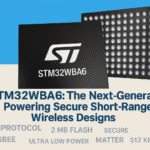 Tech Updates30 November 2025STM32WBA6: The Next-Generation MCU Powering Secure Short-Range Wireless Designs
Tech Updates30 November 2025STM32WBA6: The Next-Generation MCU Powering Secure Short-Range Wireless Designs Blogs24 November 2025High-Speed PCB Layout Design Guide-104
Blogs24 November 2025High-Speed PCB Layout Design Guide-104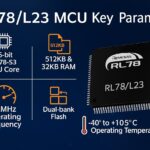 Tech Updates14 September 2025Renesas Launches RL78/L23 Ultra-Low-Power MCUs to Power Smarter Home Appliances
Tech Updates14 September 2025Renesas Launches RL78/L23 Ultra-Low-Power MCUs to Power Smarter Home Appliances Blogs7 September 2025High-Speed PCB Layout Design Guide-103
Blogs7 September 2025High-Speed PCB Layout Design Guide-103


